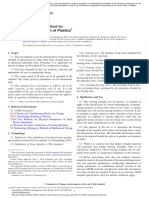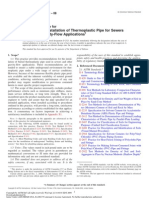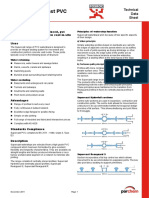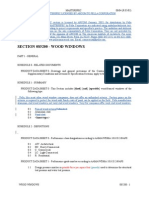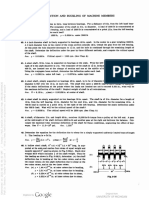Strength of Materials - PUP
Strength of Materials - PUP
Uploaded by
shirelynaCopyright:
Available Formats
Strength of Materials - PUP
Strength of Materials - PUP
Uploaded by
shirelynaOriginal Description:
Original Title
Copyright
Available Formats
Share this document
Did you find this document useful?
Is this content inappropriate?
Copyright:
Available Formats
Strength of Materials - PUP
Strength of Materials - PUP
Uploaded by
shirelynaCopyright:
Available Formats
Engr. Rex Jason H.
Agustin
STRENGTH OF MATERIALS
Strength of Materials
deals with the nature and effects of stresses in the
parts of engineering structures
Its principal object is to determine the proper size
and form of pieces which have to bear given loads,
or, conversely, to determine the loads which can be
safely applied to pieces whose dimensions and
arrangement are already given.
Stress
The ratio of the applied load to the cross-
sectional area of an element experiencing
the force.
TYPES OF SIMPLE STRESS
With normal stress, , the area is normal
to the force carried.
P
P
P
P
1. Normal / Axial Stress
= P / A
P = Tensile / Compressive Load
A = Cross Sectional Area
P
P
d
Sheared area
2. SHEARING STRESS
a. Single Shear
2
4
S
A d
t
=
= P/A
A = Total Sheared Area
Double Shear
P
P
Sheared area
= P/A
A = Total Sheared Area
A = 2 D
2
/ 4
Punching Shear
Sheared Area
p
= P / A
s
A
s
= D t
II. THIN-WALLED CYLINDERS
P
P
t
i
D
t
L
a. Tangential Stress
S
t
= D/2t
= pressure in N/mm
2
D = inside diameter
t = thickness in mm
BARLOW FORMULA
b. Longitudinal Stress
S
L
= D/4t
= pressure in N/mm
2
D = inside diameter
t = thickness in mm
Thermal Stress
Linear Expansion
L =
L
L (T)
Volumetric Expansion
V =
V
V (T)
Stress due to Thermal Expansion
Strain
A measure of the deformation of the
material that is dimensionless.
The change of shape produced by stress
= L / L
Where: = strain
L = change in length
L = original length
Hookes Law
Stress is directly proportional to Strain
named after the physicist Robert Hooke, 1676
= E ; E = /
= Stress
= Strain
E = Modulus of Elasticity
(Youngs Modulus) (GPa)
Poissons Ratio
the ratio of transverse contraction strain to longitudinal
extension strain in the direction of stretching force
Tensile deformation is considered positive and compressive
deformation is considered negative
= -
lateral
/
longitudinal
Stress Strain Graph
Elastic Limit
the point at which permanent deformation
occurs, that is, after the elastic limit, if the
force is taken off the sample, it will not return
to its original size and shape, permanent
deformation has occurred.
Proportional Limit
The greatest stress at which a material is
capable of sustaining the applied load without
deviating from the proportionality of stress to
strain.
Ultimate Strength (Tensile)
The maximum stress a material withstands
when subjected to an applied load.
The stress required to produce rupture.
Yield Strength
Stress at which material exceeds the elastic
limit and will not return to its origin shape
or length if the stress is removed.
Working Stress
the actual stress of a material under a given
loading
Allowable Stress
The maximum safe stress that a material can
carry
Factor of Safety
The ratio of ultimate strength to allowable
strength
The condition under which the stress is
constant or uniform is known as
A. Simple stress
B. Shearing stress
C. Tangential stress
D. Normal stress
The highest ordinate on the stress-strain curve
is called
A. rupture stress
B. elastic limit
C. ultimate stress or ultimate strength
D. proportional limit
Shearing stress is also known as
A. Simple stress
B. Shearing stress
C. Tangential stress
D. Normal stress
Stress caused by forces perpendicular to the
areas on which they act is called
A. Simple stress
B. Shearing stress
C. Tangential stress
D. Normal stress
What type of stress is produced whenever the
applied load cause one section of a body to
tend to slide past its adjacent section?
A. normal stress
B. sliding stress
C. shearing stress
D. bearing stress
The ratio of the unit lateral deformation to the
unit longitude deformation is called
A. compressibility
B. bulk modulus
C. shear modulus
D. Poissons ratio
It describes the length elasticity of the material.
A. Bulk modulus
B. Youngs modulus or tensile modulus
C. Modulus of Compressibility
D. Shear modulus
Determine the outside diameter of a hollow
steel tube that will carry a tensile load of 500 kN
at a stress of 140 MPa. Assume the wall
thickness to be one-tenth of the outside
diameter.
A. 132 mm C. 113 mm
B. 143 mm D. 133 mm
What force is required to punch a 20-mm
diameter hole through a 10-mm thick
plate having ultimate strength of 450
MPa?
a.) 283 kN c.) 382 kN
b.) 312 kN d.) 293 kN
A spherical pressure vessel 400-mm in
diameter has a uniform thickness of 6 mm. The
vessel contains gas under a pressure of 8 MPa.
If the ultimate tensile stress of the material is
420 MPa, what is the factor of safety with
respect to tensile failure?
A. 3.15 C. 3.4
B. 1.90 D. 2.6
A steel rod with a cross-sectional area of 150
mm
2
is stretched between two fixed points. The
tensile load at 20C is 5000 N. What will be the
stress at -20C? Assume =11.7 m/m C and
E=200x10
9
N/m2.
A. 112.8 MPa C. 132.4 MPa
B. 117.9 MPa D. 126.9 MPa
Elongation ()
P = Force
L = Original Length
A = Cross Sectional Area
E = Youngs Modulus
= PL / AE
Elongation due to Weight ()
= unit mass
g = gravity
E = Youngs Modulus
= gL
2
/ 2E
A steel rod having a cross-sectional area of
300mm
2
and length of 150 m is suspended
vertically from one end .It supports a load of 20
kN at the lower end. If the unit mass of steel is
7850 kg/m
3
and E=200 GPa, find the total
elongation of the rod.
A. 33.45 mm C. 53.44 mm
B. 54.33 mm D. 35.44 mm
The straight-line portion of the stress-strain
diagram has slope equal to the
_____________of the material.
A. modulus of rigidity
B. compressibility
C. modulus of elasticity
D. shear modulus
The stress beyond which the material will not
return to its original shape when unloaded is
called
A. elastic limit
B. maximum stress
C. ultimate stress
D. allowable stress
Torsion
In solid mechanics, it is the twisting of an
object due to an applied torque
Torsion
MAX
= T*r / J
MAX
= maximum shear stress
J = polar moment of inertia
r = outer radius of the shaft
c
Polar Moment of Inertia
Solid Shaft:
J = D
4
/ 32
Hollow Shaft:
J = (D
o
4
D
i
4
) / 32
Angle of Twist
= TL / JG
T = Torque
L = Length
J = Polar Moment of Inertia
G = Shear Modulus
Power Transmitted by Shaft
P = T = T(2f)
or
P = 2 T n
P = power (W)
T = Torque (Nm)
f = frequency (Hz)
n = angular speed (rev/s)
What is the minimum diameter of a solid steel
shaft that will not twist through more than 3 in a
6-m length when subjected to a torque of 14
kN-m? Use G=83 GN/m2.
A. 118 mm
B. 145 mm
C. 122 mm
D. 113 mm
Determine the length of the shortest 2-mm
diameter bronze wire which can be twisted
through two complete turns without exceeding a
shearing stress of 70 MPa. Use G=35 GPa.
A. 6280 mm
B. 3420 mm
C. 1280 mm
D. 1658 mm
Spring
device made of an elastic material that
undergoes a significant change in shape, or
deformation, under an applied load
Helical Spring
a spiral wound wire with a constant coil
diameter and uniform pitch
Common Forms:
Compression Spring
Tension Spring
Helical Spring
Max Shearing Stress
Approximate:
Exact:
R = mean radius of spring (D is mean diameter)
d = diameter of wire
m = D/d
max
3
16PR d
1
d 4R
| |
t = +
|
t
\ .
max
3
16PR 4m 1 0.615
d 4m 4 m
| |
t = +
|
t
\ .
Spring Deformation
= 64PR
3
n / Gd
4
P
L
o
Determine the maximum shearing stress in a
helical steel spring composed of 20 turns of 20-
mm diameter wire on a mean radius of 80 mm
when the spring is supporting a load of 2kN.
A. 120.6 MPa
B. 117.9 MPa
C. 132.4 MPa
D. 126.9 MPa
CABLES
I. Parabolic
Parabolic Cable
Tension at the Support
T
2
= (L/2)
2
+ H
2
Approximate Length of Cable
S = L + 8d
2
/3L 32d
4
/5L
3
Tension at the Lowest Point
H = L
2
/ 8d
L = Horizontal Span
d = sag of cable
= weight per unit length
II. Catenary
The theoretical shape of a
hanging flexible chain or
cable when supported at its
ends and acted upon by a
uniform gravitational force
(its own weight) and in
equilibrium. The curve has
a U shape that is similar in
appearance to the
parabola, though it is a
different curve.
Catenary Cable
Tension at the support
T
L
= y
L
1 1 2 2
1 2
Distance Between supports :
S y S y
x cln x cln
c c
+ +
| | | |
= =
| |
\ . \ .
( )
( ) ( )
1 2
2
2
1 1
2 2
2 2
Tension at the support T & T :
T H S
T H S
= + e
= + e
( ) ( ) ( )
( ) ( ) ( )
2 2 2
1 1
2 2 2
2 2
Relationship among S, y &c :
S y c
S y c
=
=
Catenary
= weight per unit length
y = height of the support (respective)
c = minimum clearance from the ground
S = cable length (respective)
What tension must be applied at the ends of an
aluminum cable supporting a load of 0.5 kg per
horizontal meter in a span of 100 m if the sag is
to be limited to 1.25 m?
A. 423.42 kg
B. 329.82 kg
C. 500.62 kg
D. 184.29 kg
Calculate the allowable spacing of the two
towers to carry a flexible wire cable weighing
0.03 kg per horizontal meter if the maximum
tension at the lowest point is not to exceed 1150
kg at sag of 0.50 m.
A. 248 m C. 390 m
B. 408 m D. 422 m
A cable 600 m long weighing 1500 N per meter
has tension of 750 kN at each end. Compute
the maximum sag of the cable.
A. 200 m
B. 150 m
C. 100 m
D. 220 m
The light cable supports a mass of 12 kg per
meter of horizontal length and is suspended
between the two points on the same level 300
m apart. If the sag is 60 m, find the total length
of the cable.
A. 329 m C. 139 m
B. 239 m D. 429 m
TO GOD BE THE GLORY!
End of session.
You might also like
- CSM 10423RDocument53 pagesCSM 10423RWyllton CandidoNo ratings yet
- Technical Writing A-Z: A Commonsense Guide to Engineering Reports and Theses, Second Edition, British English: A Commonsense Guide to Engineering Reports and Theses, U.S. English Second EditionFrom EverandTechnical Writing A-Z: A Commonsense Guide to Engineering Reports and Theses, Second Edition, British English: A Commonsense Guide to Engineering Reports and Theses, U.S. English Second EditionNo ratings yet
- F1056-04 (Reapproved 2011)Document4 pagesF1056-04 (Reapproved 2011)Deepak AryaNo ratings yet
- ASTM A184 Welded Deformed Steel Bar Mats For Concrete ReinforcementDocument2 pagesASTM A184 Welded Deformed Steel Bar Mats For Concrete ReinforcementAmanda Ariesta Aprilia100% (1)
- Static Load Testing of Truss Assemblies: Standard Practice ForDocument5 pagesStatic Load Testing of Truss Assemblies: Standard Practice FordgkmurtiNo ratings yet
- D953 1714809-1Document6 pagesD953 1714809-1NitinNo ratings yet
- Fully Deteriorated Cipp DesignDocument3 pagesFully Deteriorated Cipp DesignAnonymous YcAZv5qF67No ratings yet
- F 714 - 00 Rjcxnc0wmaDocument9 pagesF 714 - 00 Rjcxnc0wmaPierre ZuñigaNo ratings yet
- D2321Document11 pagesD2321Timothy McmillanNo ratings yet
- Astm d2444 21 落锤试验机标准Document10 pagesAstm d2444 21 落锤试验机标准Avin WangNo ratings yet
- Astm A 139 - A 139M - 00 QTEZOS9BMTM5TS1SRUQ - PDFDocument9 pagesAstm A 139 - A 139M - 00 QTEZOS9BMTM5TS1SRUQ - PDFMercedes Villacis TroncosoNo ratings yet
- Form WorkDocument64 pagesForm WorkAnjali ShahNo ratings yet
- Tek 18-01B5 PDFDocument8 pagesTek 18-01B5 PDFMohamed HNo ratings yet
- Nondestructive Evaluation of Wood-Based Flexural Members Using Transverse VibrationDocument8 pagesNondestructive Evaluation of Wood-Based Flexural Members Using Transverse Vibrationasma hamzaNo ratings yet
- Astm C145 85Document2 pagesAstm C145 85Jorge Patazca100% (1)
- Ufgs 13 34 19Document45 pagesUfgs 13 34 19sharandeep1112No ratings yet
- Wind Turbine API RP2 SeriesDocument8 pagesWind Turbine API RP2 SeriesBona_VentureNo ratings yet
- ASTM A 795 - Steel Pipe For Fire ProtectionDocument5 pagesASTM A 795 - Steel Pipe For Fire ProtectionQfg Proiect SrlNo ratings yet
- Toe QuestDocument4 pagesToe Questrameshbabu_1979No ratings yet
- Pressure Method - AASHTO T 152 (ASTM C231)Document5 pagesPressure Method - AASHTO T 152 (ASTM C231)Einstein JeboneNo ratings yet
- Astm D2729-11Document5 pagesAstm D2729-11UNUSED MUSIC MIRANDANo ratings yet
- Aashto M182Document1 pageAashto M182azeem sarwar0% (1)
- Design of FalseworkDocument15 pagesDesign of FalseworkSarada DalaiNo ratings yet
- Underground Installation of Thermoplastic Pipe For Sewers and Other Gravity-Flow ApplicationsDocument12 pagesUnderground Installation of Thermoplastic Pipe For Sewers and Other Gravity-Flow ApplicationsalexsiqueirosNo ratings yet
- Aci 515.1R-79Document44 pagesAci 515.1R-79Leobardo De la Rosa SánchezNo ratings yet
- ASTM-C666-C666M-15Document3 pagesASTM-C666-C666M-15Hendawy AbotawelaNo ratings yet
- 330 1-03 PDFDocument6 pages330 1-03 PDFsaeidcivil89No ratings yet
- Fluid Loss of Clay Component of Geosynthetic Clay Liners: Standard Test Method ForDocument3 pagesFluid Loss of Clay Component of Geosynthetic Clay Liners: Standard Test Method ForDanZel DanNo ratings yet
- Construction of Chain-Link Tennis Court Fence: Standard Practice ForDocument4 pagesConstruction of Chain-Link Tennis Court Fence: Standard Practice ForKevin JosueNo ratings yet
- Astm Specifications With Reference To Aashto SpecificationsDocument3 pagesAstm Specifications With Reference To Aashto SpecificationsHermann PankowNo ratings yet
- Tek 10-03Document4 pagesTek 10-03Thai DamNo ratings yet
- c700 WW LL 58 02-11Document2 pagesc700 WW LL 58 02-11alexisNo ratings yet
- Astm A529 1975Document4 pagesAstm A529 1975dharlanuctcomNo ratings yet
- ICC-ES-AC 291-19 ACCREDITATION CRITERIA FOR SPECIAL INSPECTION AGENCIES - Sep-2019Document21 pagesICC-ES-AC 291-19 ACCREDITATION CRITERIA FOR SPECIAL INSPECTION AGENCIES - Sep-2019rcfNo ratings yet
- Fusion-Bonded Epoxy-Coated Structural Steel H-Piles and Sheet PilingDocument5 pagesFusion-Bonded Epoxy-Coated Structural Steel H-Piles and Sheet PilingSama UmateNo ratings yet
- Admix Catalog 2015 16 Web LinksDocument248 pagesAdmix Catalog 2015 16 Web Linksdan0427No ratings yet
- Khodaie Et Al-ACI Spring 2016Document13 pagesKhodaie Et Al-ACI Spring 2016erosNo ratings yet
- Benchmarking The Structural Condition of Flexible Pavements With Deflection Bowl ParametersDocument8 pagesBenchmarking The Structural Condition of Flexible Pavements With Deflection Bowl ParametersPieter HutagalungNo ratings yet
- ASTM A194 NutsDocument13 pagesASTM A194 NutsDan ClarkeNo ratings yet
- FAQ 11-14 - ASTM C90 CommentaryDocument16 pagesFAQ 11-14 - ASTM C90 Commentarymido_20067581100% (1)
- Asme B16.26 PDFDocument13 pagesAsme B16.26 PDFRuben Dario Mamani Arellano100% (1)
- Fundamental of Bridge InspectionDocument31 pagesFundamental of Bridge InspectionSeptinurriandianiNo ratings yet
- Fosroc Supercast PVC Waterstops: Technical Data SheetDocument4 pagesFosroc Supercast PVC Waterstops: Technical Data Sheetarvin jay santarinNo ratings yet
- Response 2000Document1 pageResponse 2000Cristian AndreiNo ratings yet
- Double Check Valve Backflow Prevention Assembly (DCVA) (Standard ASSE 1015)Document2 pagesDouble Check Valve Backflow Prevention Assembly (DCVA) (Standard ASSE 1015)RoNo ratings yet
- When To Challenge Petrographic Reports - tcm45-347346Document4 pagesWhen To Challenge Petrographic Reports - tcm45-347346Dan TranNo ratings yet
- Errors Inherent in Directional Surveying With MWD Tools.Document10 pagesErrors Inherent in Directional Surveying With MWD Tools.Dhiaa LaMi100% (1)
- 085200fl PellaDocument21 pages085200fl PellaabobeedoNo ratings yet
- 2003 Fronapfel FINALDocument8 pages2003 Fronapfel FINALVojkan MladenovicNo ratings yet
- Members in Compression - AISC RequirementsDocument17 pagesMembers in Compression - AISC RequirementsPatricia AllyNo ratings yet
- ACI 347R-14: Cece, Alnazer A. Bs Civil Engineering - 5 YearDocument25 pagesACI 347R-14: Cece, Alnazer A. Bs Civil Engineering - 5 YearLnazerA.CeceNo ratings yet
- Low Pressure Test FormDocument2 pagesLow Pressure Test FormNor Azman OsmanNo ratings yet
- ANSI ASAE EP 433 (1991) Loads Exerted by Free-Flowing Grain On BinsDocument4 pagesANSI ASAE EP 433 (1991) Loads Exerted by Free-Flowing Grain On Binscarlosgmon2No ratings yet
- Assessment, Remediation and Acceptance of Drilled Shafts Through The Use of CSL TestsDocument10 pagesAssessment, Remediation and Acceptance of Drilled Shafts Through The Use of CSL TestsoioioiNo ratings yet
- CompositeDocument36 pagesCompositeAlaa AlmalkiNo ratings yet
- Schedule 40 Pipe, Galvanized: ASTM F1043 Group I-A, Federal Specification RR-F-191 Type 1, Grade A, AASHTO M-181 Grade 1Document2 pagesSchedule 40 Pipe, Galvanized: ASTM F1043 Group I-A, Federal Specification RR-F-191 Type 1, Grade A, AASHTO M-181 Grade 1Caolboy ButchNo ratings yet
- PCA An Engineers Guide To Economical Concrete Floor SystemsDocument6 pagesPCA An Engineers Guide To Economical Concrete Floor SystemsYam BalaoingNo ratings yet
- Typar Commercial BrochureDocument8 pagesTypar Commercial BrochurededspiderfishNo ratings yet
- Ncma Tek: Glossary of Concrete Masonry Terms TEK 1-4Document6 pagesNcma Tek: Glossary of Concrete Masonry Terms TEK 1-4Heriberto Yau BNo ratings yet
- s4670 Eprinter Instruction ManualDocument44 pagess4670 Eprinter Instruction Manualmtim360No ratings yet
- Metrology QBDocument16 pagesMetrology QBSubin RajNo ratings yet
- THESIS - TMP Without ReferencesDocument43 pagesTHESIS - TMP Without Referencesjawad khalidNo ratings yet
- Element SupersDocument6 pagesElement Supersapi-245183065No ratings yet
- Galvanometer's Conversion To Ammeter and VoltmeterDocument1 pageGalvanometer's Conversion To Ammeter and Voltmeteranshvishwakarma2005No ratings yet
- Science 8 3.2 Uniform Circular MotionDocument24 pagesScience 8 3.2 Uniform Circular MotionJoseph De ChavezNo ratings yet
- History: Conductive Polymers Or, More Precisely, Intrinsically Conducting Polymers (Icps)Document3 pagesHistory: Conductive Polymers Or, More Precisely, Intrinsically Conducting Polymers (Icps)godseNo ratings yet
- Data Sheets PDFDocument7 pagesData Sheets PDFshareyhouNo ratings yet
- MF50 Anti Leak Silicone TapeDocument2 pagesMF50 Anti Leak Silicone Tapejunjiewang094No ratings yet
- Shear Wall: Swithin PhilipDocument12 pagesShear Wall: Swithin PhilipKiranNo ratings yet
- Optimization of Ship Hull Parameter of Inland Vessel With Respect To Regression Based Resistance Analysis PDFDocument6 pagesOptimization of Ship Hull Parameter of Inland Vessel With Respect To Regression Based Resistance Analysis PDFPierluigiBusettoNo ratings yet
- Twistlock TestingDocument44 pagesTwistlock Testingkandahar_specNo ratings yet
- Water Flow Visualization and Velocity Measurement Using Hydrogen Bubble Generation Technique in Low Speed Open ChannelDocument15 pagesWater Flow Visualization and Velocity Measurement Using Hydrogen Bubble Generation Technique in Low Speed Open ChannelarunkumrNo ratings yet
- Phys ReviseDocument1 pagePhys ReviseJohan O'LearyNo ratings yet
- Principles of Crystal Nucleation and GrowthDocument37 pagesPrinciples of Crystal Nucleation and GrowthGinoDelgadoNo ratings yet
- ASTM F 382 Experiment - 1 - FoyDocument2 pagesASTM F 382 Experiment - 1 - FoyLucas MlbNo ratings yet
- Fisher Fieldvue DVC6200 SIS Digital Valve Controller For Safety Instrumented Systems (SIS)Document8 pagesFisher Fieldvue DVC6200 SIS Digital Valve Controller For Safety Instrumented Systems (SIS)Limuel EspirituNo ratings yet
- Es 2004 12Document4 pagesEs 2004 12HirenkumarNo ratings yet
- Week 4 - Skate Park Phet LabDocument3 pagesWeek 4 - Skate Park Phet LabSavannah RoseNo ratings yet
- Calculate Flow Rate of Air Through A Pressurized HoleDocument2 pagesCalculate Flow Rate of Air Through A Pressurized Holeleonard1971No ratings yet
- Kinetics of A System of ParticlesDocument16 pagesKinetics of A System of Particleszoom^2No ratings yet
- Pile Capacity - BYWGDocument70 pagesPile Capacity - BYWGHamidAffandyNo ratings yet
- Deflection Buckling Members: AND OFDocument1 pageDeflection Buckling Members: AND OFjethro ganeloNo ratings yet
- Solar SystemDocument27 pagesSolar Systemapi-282019523No ratings yet
- IEC Symbols DesignationsDocument20 pagesIEC Symbols Designationshalel111No ratings yet
- Structural Health MonitoringDocument3 pagesStructural Health MonitoringDiana Rose B. DatinguinooNo ratings yet
- Snow Density and Its Underlying Variables - ThutDocument7 pagesSnow Density and Its Underlying Variables - ThutSen HuNo ratings yet
- Assignment 5Document3 pagesAssignment 5samtech007No ratings yet
- Articles-58277 Resource 4Document6 pagesArticles-58277 Resource 4Vinod Kumar VermaNo ratings yet
- Analysis of Stress Concentrations in ANSYS APDLDocument9 pagesAnalysis of Stress Concentrations in ANSYS APDLudaykumar8995No ratings yet





